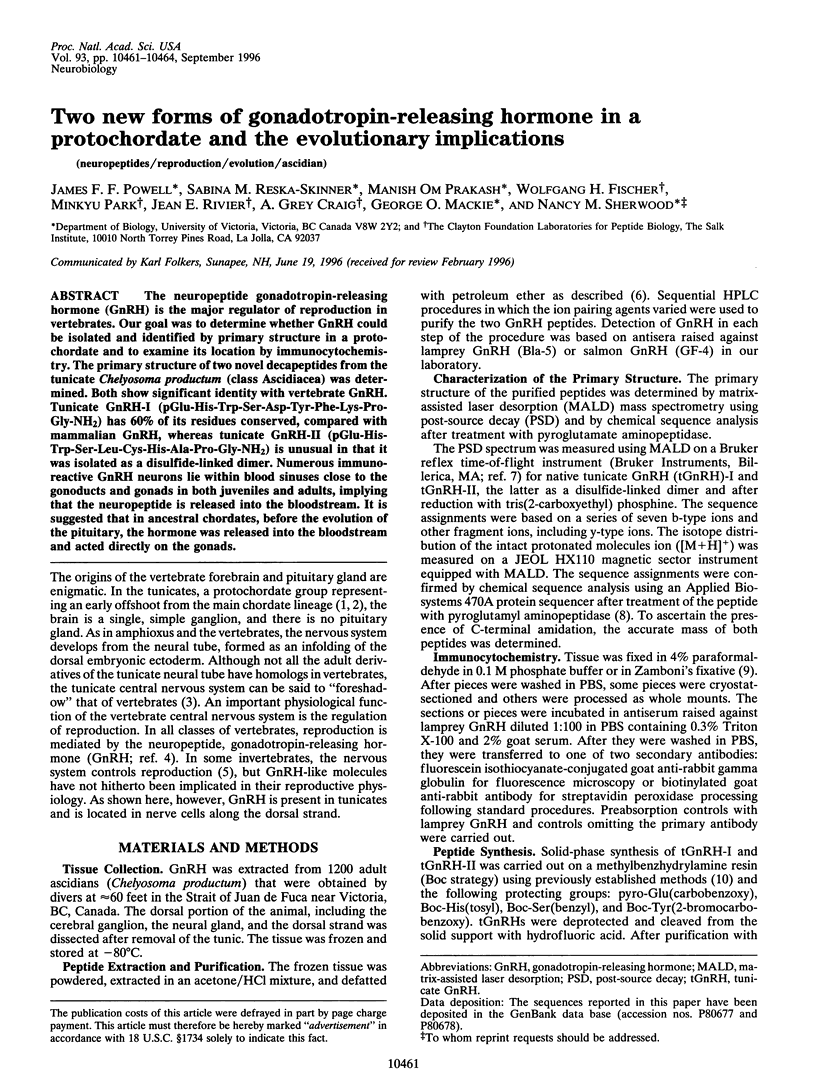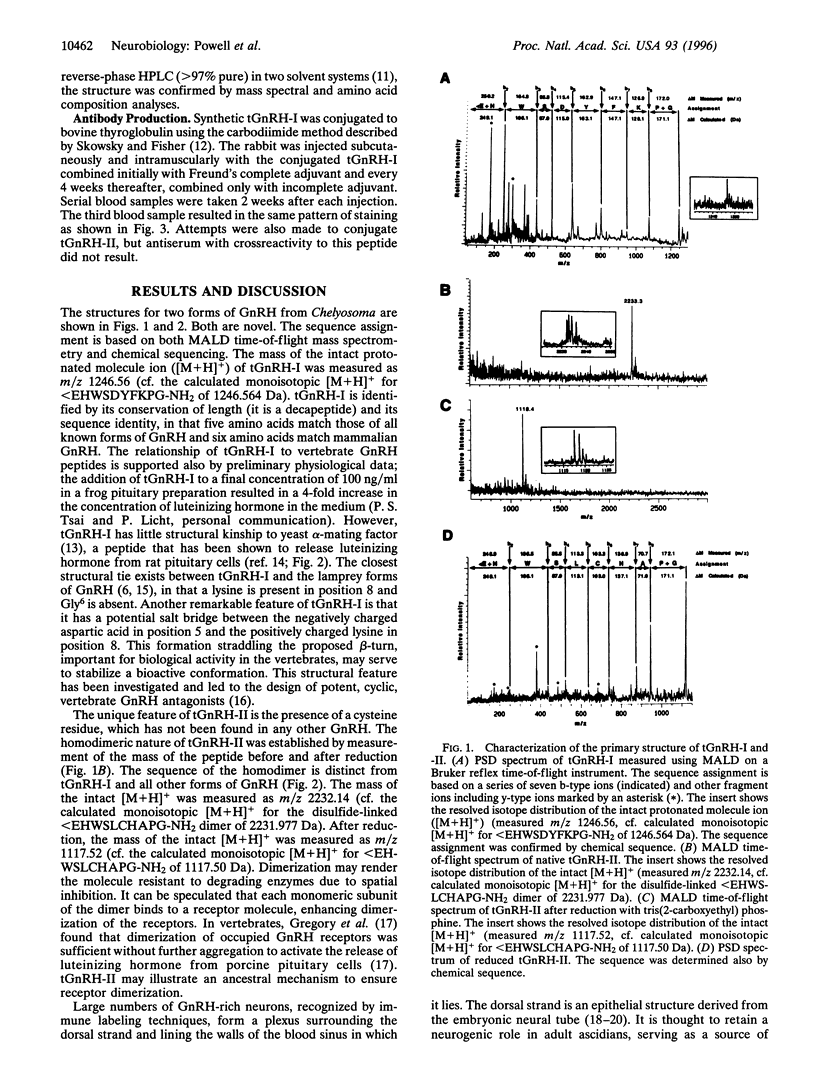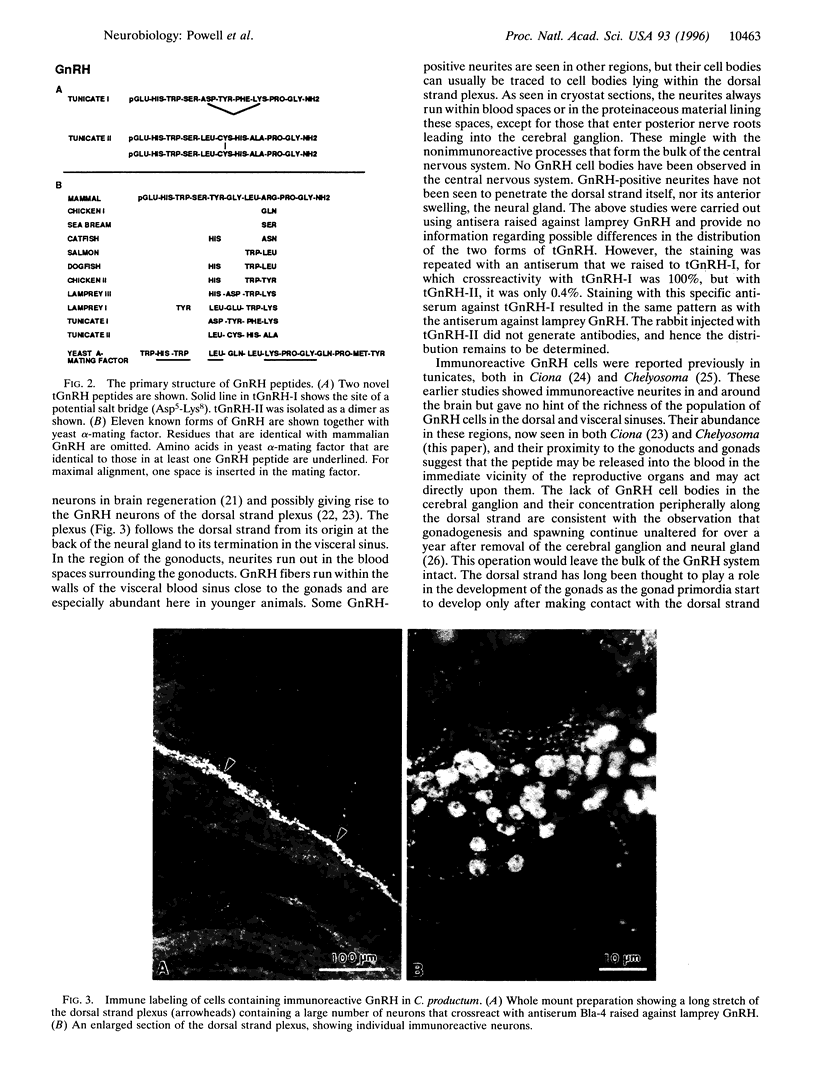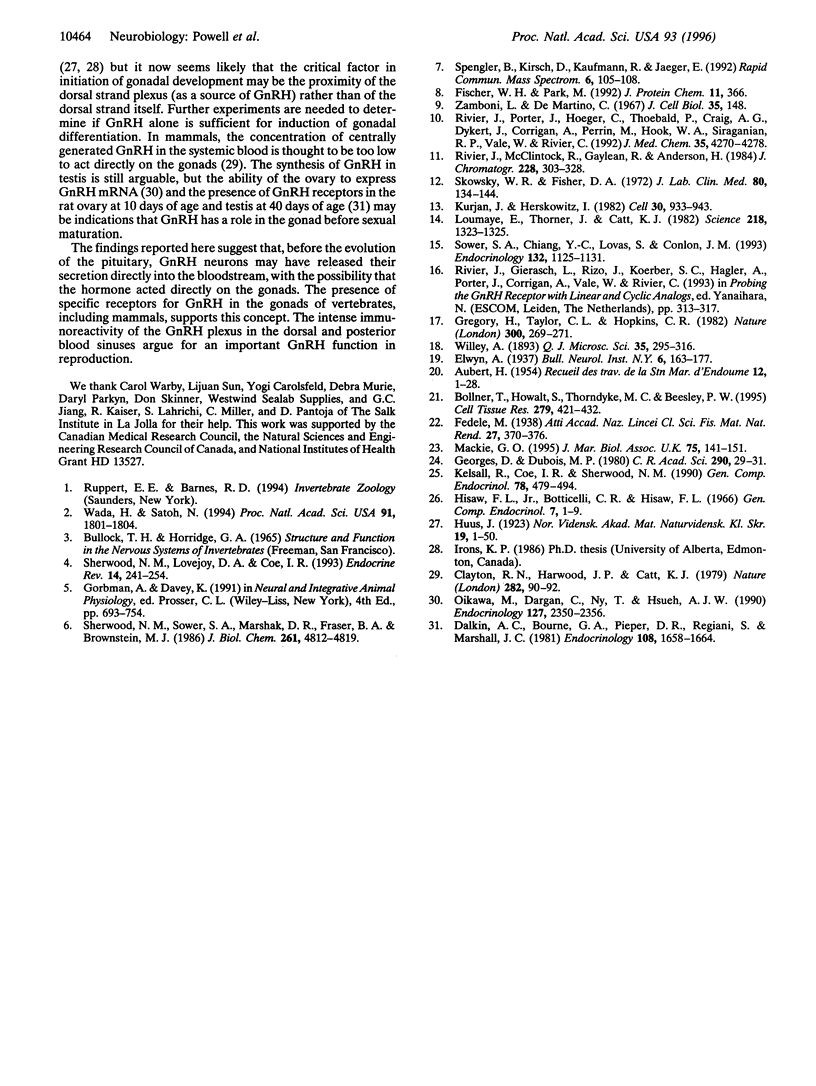Abstract
The neuropeptide gonadotropin-releasing hormone (GnRH) is the major regulator of reproduction in vertebrates. Our goal was to determine whether GnRH could be isolated and identified by primary structure in a protochordate and to examine its location by immunocytochemistry. The primary structure of two novel decapeptides from the tunicate Chelyosoma productum (class Ascidiacea) was determined. Both show significant identity with vertebrate GnRH. Tunicate GnRH-I (pGlu-His-Trp-Ser-Asp-Tyr-Phe-Lys-Pro-Gly-NH2) has 60% of its residues conserved, compared with mammalian GnRH, whereas tunicate GnRH-II (pGlu-His-Trp-Ser-Leu-Cys-His-Ala-Pro-Gly-NH2) is unusual in that it was isolated as a disulfide-linked dimer. Numerous immunoreactive GnRH neurons lie within blood sinuses close to the gonoducts and gonads in both juveniles and adults, implying that the neuropeptide is released into the bloodstream. It is suggested that in ancestral chordates, before the evolution of the pituitary, the hormone was released into the bloodstream and acted directly on the gonads.
Full text
PDF



Images in this article
Selected References
These references are in PubMed. This may not be the complete list of references from this article.
- Bollner T., Howalt S., Thorndyke M. C., Beesley P. W. Regeneration and post-metamorphic development of the central nervous system in the protochordate Ciona intestinalis: a study with monoclonal antibodies. Cell Tissue Res. 1995 Feb;279(2):421–432. doi: 10.1007/BF00318500. [DOI] [PubMed] [Google Scholar]
- Clayton R. N., Harwood J. P., Catt K. J. Gonadotropin-releasing hormone analogue binds to luteal cells and inhibits progesterone production. Nature. 1979 Nov 1;282(5734):90–92. doi: 10.1038/282090a0. [DOI] [PubMed] [Google Scholar]
- Dalkin A. C., Bourne G. A., Pieper D. R., Regiani S., Marshall J. C. Pituitary and gonadal gonadotropin-releasing hormone receptors during sexual maturation in the rat. Endocrinology. 1981 May;108(5):1658–1664. doi: 10.1210/endo-108-5-1658. [DOI] [PubMed] [Google Scholar]
- Georges D., Dubois M. P. Mise en évidence par les techniques d'immunofluorescence d'un antigène de type LH-RH dans le système nerveux de Ciona intestinalis (Tunicier ascidiacé). C R Seances Acad Sci D. 1980 Jan 7;290(1):29–31. [PubMed] [Google Scholar]
- Gregory H., Taylor C. L., Hopkins C. R. Luteinizing hormone release from dissociated pituitary cells by dimerization of occupied LHRH receptors. Nature. 1982 Nov 18;300(5889):269–271. doi: 10.1038/300269a0. [DOI] [PubMed] [Google Scholar]
- Kelsall R., Coe I. R., Sherwood N. M. Phylogeny and ontogeny of gonadotropin-releasing hormone: comparison of guinea pig, rat, and a protochordate. Gen Comp Endocrinol. 1990 Jun;78(3):479–494. doi: 10.1016/0016-6480(90)90037-m. [DOI] [PubMed] [Google Scholar]
- Kurjan J., Herskowitz I. Structure of a yeast pheromone gene (MF alpha): a putative alpha-factor precursor contains four tandem copies of mature alpha-factor. Cell. 1982 Oct;30(3):933–943. doi: 10.1016/0092-8674(82)90298-7. [DOI] [PubMed] [Google Scholar]
- Loumaye E., Thorner J., Catt K. J. Yeast mating pheromone activates mammalian gonadotrophs: evolutionary conservation of a reproductive hormone? Science. 1982 Dec 24;218(4579):1323–1325. doi: 10.1126/science.6293058. [DOI] [PubMed] [Google Scholar]
- Oikawa M., Dargan C., Ny T., Hsueh A. J. Expression of gonadotropin-releasing hormone and prothymosin-alpha messenger ribonucleic acid in the ovary. Endocrinology. 1990 Nov;127(5):2350–2356. doi: 10.1210/endo-127-5-2350. [DOI] [PubMed] [Google Scholar]
- Rivier J., McClintock R., Galyean R., Anderson H. Reversed-phase high-performance liquid chromatography: preparative purification of synthetic peptides. J Chromatogr. 1984 Apr 24;288(2):303–328. doi: 10.1016/s0021-9673(01)93709-4. [DOI] [PubMed] [Google Scholar]
- Rivier J., Porter J., Hoeger C., Theobald P., Craig A. G., Dykert J., Corrigan A., Perrin M., Hook W. A., Siraganian R. P. Gonadotropin-releasing hormone antagonists with N omega-triazolylornithine, -lysine, or -p-aminophenylalanine residues at positions 5 and 6. J Med Chem. 1992 Nov 13;35(23):4270–4278. doi: 10.1021/jm00101a003. [DOI] [PubMed] [Google Scholar]
- Sherwood N. M., Lovejoy D. A., Coe I. R. Origin of mammalian gonadotropin-releasing hormones. Endocr Rev. 1993 Apr;14(2):241–254. doi: 10.1210/edrv-14-2-241. [DOI] [PubMed] [Google Scholar]
- Sherwood N. M., Sower S. A., Marshak D. R., Fraser B. A., Brownstein M. J. Primary structure of gonadotropin-releasing hormone from lamprey brain. J Biol Chem. 1986 Apr 15;261(11):4812–4819. [PubMed] [Google Scholar]
- Skowsky W. R., Fisher D. A. The use of thyroglobulin to induce antigenicity to small molecules. J Lab Clin Med. 1972 Jul;80(1):134–144. [PubMed] [Google Scholar]
- Sower S. A., Chiang Y. C., Lovas S., Conlon J. M. Primary structure and biological activity of a third gonadotropin-releasing hormone from lamprey brain. Endocrinology. 1993 Mar;132(3):1125–1131. doi: 10.1210/endo.132.3.8440174. [DOI] [PubMed] [Google Scholar]
- Spengler B., Kirsch D., Kaufmann R., Jaeger E. Peptide sequencing by matrix-assisted laser-desorption mass spectrometry. Rapid Commun Mass Spectrom. 1992 Feb;6(2):105–108. doi: 10.1002/rcm.1290060207. [DOI] [PubMed] [Google Scholar]
- Wada H., Satoh N. Details of the evolutionary history from invertebrates to vertebrates, as deduced from the sequences of 18S rDNA. Proc Natl Acad Sci U S A. 1994 Mar 1;91(5):1801–1804. doi: 10.1073/pnas.91.5.1801. [DOI] [PMC free article] [PubMed] [Google Scholar]



